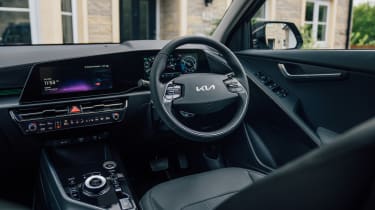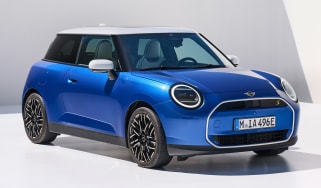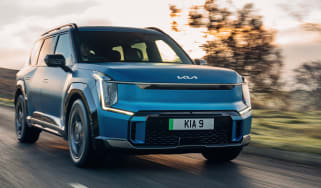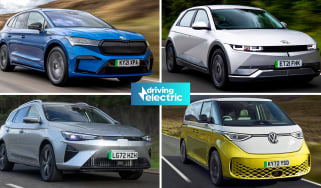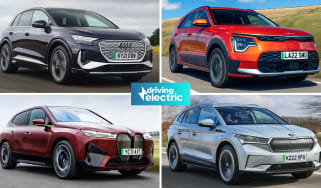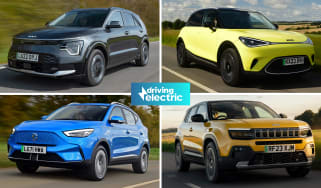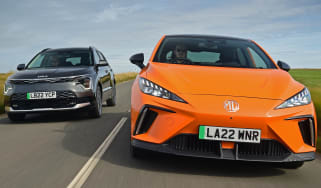Kia Niro EV review
The new Niro EV picks up right where the e-Niro left off, adding sharper styling and intuitive infotainment to the brand’s popular electric family-car package
Pros
- Attractive new styling
- Still supremely efficient
- Technology improvements
Cons
- Range and performance unchanged
- Slow charging technology
- Road noise
| Car type | Range | Wallbox charging time | Rapid charge time |
|---|---|---|---|
| Electric | 285 miles | 10hrs 30mins (0-100%, 7.4kW) | 45mins (10-80%, 72kW) |
Kia Niro EV verdict
The Kia Niro EV picks up exactly where the much-loved e-Niro left off. Its distinctive looks certainly help set it apart from rivals, as do its class-leading on-board technology, practicality, efficiency and range. It may not be the most exhilarating electric car to drive, and is behind the curve when it comes to charging speeds, but it looks like Kia’s faithful electric family car will continue to be a popular choice for years to come.
Range details, specs and alternatives
The Kia e-Niro became one of the UK’s most popular electric cars following its launch back in 2018, offering refinement, range and practicality at an affordable price for a zero-emissions family car. But in 2022, the e-Niro was laid to rest and replaced by its all-new, sharper-looking replacement: the Niro EV.
The Niro is the sister car to the Hyundai Kona (which is also about to be replaced), and serves as the South Korean brand’s baby SUV, sitting below the Sportage family SUV and seven-seater Sorento. It also slots in between the Soul EV and flagship EV6 in Kia’s current electric-car line-up.
Every Niro EV is powered by a 64.8kWh battery and 201bhp electric motor carried over from the old e-Niro, with range increasing ever so slightly for the new model from 282 to 285 miles. That’s a relatively healthy figure and slightly more than compact electric SUVs like the MG ZS EV and Smart #1 can cover on a single charge, but we still wish the Niro EV could crack the 300-mile mark.
Another minor complaint we have is with the Niro EV’s 72kW maximum charging speed which, while it can charge the car from 10-80% in just 45 minutes when connected to a 100kW public rapid charger, is no improvement over the old e-Niro. Rivals top 100kW or more, which feels more fitting in this day and age.
Other electric family cars in the Niro EV’s price range are primarily hatchbacks, including the Volkswagen ID.3, Cupra Born, Renault Megane E-Tech and our 2023 Car of the Year, the MG4 EV. However, the range-topping Niro EV doesn’t represent the best value for money in our opinion, as it has a similar price tag to a mid-range version of the much larger, more advanced Skoda Enyaq iV.
The electric Niro is available in three trim levels, simply called 2, 3 and 4, and currently starts from close to £37,000, rising to over £42,000 for the top-spec version. Standard kit is generous, with every model getting LED headlights, rear parking sensors, a rear-view camera, a 10.25-inch driver’s display, Android Auto and Apple CarPlay connectivity, plus 17-inch alloy wheels. The base model also features an eight-inch central touchscreen, while 3 and 4 spec Niros get another 10.25-inch display.
As well as the larger touchscreen, 3-spec Niros also come with front parking sensors, heated front seats and steering wheel, plus keyless entry and start – this is our pick of the range. Meanwhile, the top-of-the-range Niro 4 gets luxuries like a head-up display, sunroof, faux-leather upholstery, Harman Kardon sound system and the option to have contrastingly coloured C-pillar ‘blades’. You also can add a heat pump to the 3 and 4 models to more efficiently warm the cabin in colder months.

Make sure to check out our twin test between the Kia Niro and MG4 EV, or for a more detailed look at the Niro EV, read on for the rest of our in-depth review...

